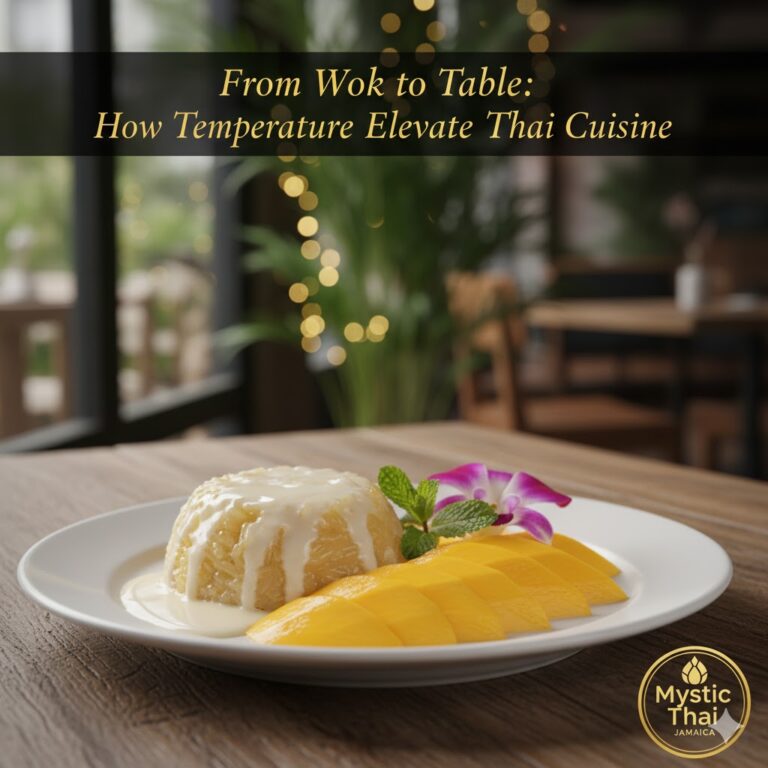Introduction
At Mystic Thai Jamaica, cooking isn’t just about ingredients—it’s about temperature. Heat plays a crucial role in Thai cuisine, affecting aroma, texture, and flavor balance. From sizzling woks to perfectly chilled desserts, each dish is crafted with precision to maximize taste and elevate the dining experience.
Temperature guides every stage: stir-frying at high heat for smoky aroma, simmering curries to develop depth, and serving dishes at the ideal warmth to highlight fresh, vibrant flavors.
1. High-Heat Stir-Frying: Unlocking Aroma and Flavor
Stir-frying over high heat is central to Thai cooking. Rapid cooking locks in juices, caramelizes sugars, and releases fragrant aromas from chilies, garlic, and basil.
The intense heat creates the distinctive wok hei—a smoky, layered flavor that defines favorites like Pad Thai and Pad Kra Pao.
2. Simmering Curries: Depth Through Gentle Heat
Curries rely on gentle, controlled heat to allow coconut milk, herbs, and spices to meld into a harmonious sauce. Slow simmering extracts maximum flavor from each ingredient without burning or curdling.
This technique ensures every spoonful delivers richness, balance, and depth, a hallmark of Mystic Thai’s signature curries.
3. Chilled and Room-Temperature Dishes: Freshness and Contrast
Not all dishes are served piping hot. Salads like Som Tum or desserts such as Mango Sticky Rice rely on chilled or room-temperature preparation to preserve crispness, natural sweetness, and vibrant colors.
Temperature contrast between hot mains and cool accompaniments adds layers to the dining experience.

4. Serving Temperature: Maximizing Flavor Impact
Beyond cooking, the serving temperature is carefully monitored. Rice should be steaming, stir-fries sizzling, and soups warm but not scalding. Properly managed serving temperatures enhance texture, aroma, and flavor perception, ensuring that each dish is as enjoyable at first bite as the last.
5. Balancing Heat and Cooling Elements
Thai cuisine often balances spicy heat with cooling components: coconut milk, cucumber, or yogurt-based accompaniments. This interplay of hot and cool creates a dynamic, multi-sensory experience that is both satisfying and refreshing—especially for Jamaican diners seeking bold flavor without overwhelming heat.
Final Thoughts
At Mystic Thai Jamaica, temperature is a secret ingredient. Every dish—from wok-fried noodles to chilled desserts—is prepared and served at the perfect temperature to maximize flavor, texture, and enjoyment. By controlling heat thoughtfully, our chefs ensure that every plate delights the senses and celebrates authentic Thai cuisine with a touch of island freshness.
👉 Visit our menu and taste Thai cuisine cooked and served at its best.
FAQs: Temperature in Thai Cooking
Q1: Why is temperature so important in Thai cooking?
It affects aroma, texture, and flavor balance, ensuring dishes are enjoyable from the first bite to the last.
Q2: Can I request adjustments to spice or heat levels?
Yes—our chefs tailor spice and heat levels to your preference while maintaining ideal cooking temperatures.
Q3: Are cold or room-temperature dishes common in Thai cuisine?
Yes—salads and desserts often benefit from cooler temperatures to preserve freshness and texture.
Q4: Does high-heat cooking affect nutritional value?
High-heat stir-frying is quick, locking in nutrients while creating complex flavors.
Q5: How do Mystic Thai chefs ensure proper serving temperature?
Chefs carefully monitor each dish from kitchen to table, serving mains hot, soups warm, and desserts cool for optimal enjoyment.


